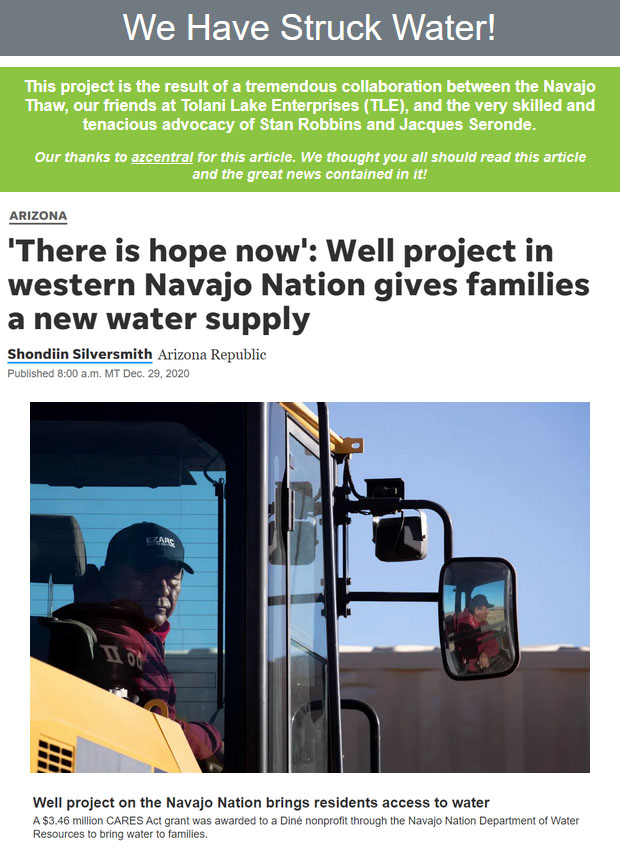We Have Struck Water!
Walking along the run-down wire fence of her family's farm plot, Eileen Tohonnie recalls a time when her family was able to plant every spring.
The family's plot sits along the Little Colorado River in Black Falls, Arizona, on the Navajo Nation. Black Falls is about an hour north of Flagstaff, near Wupatki National Monument.
Tohonnie, 59, said her mother loved to plant corn, and when the river was flowing, her older brother Ronald Tohonnie would help pump water for their crops directly from the river. In months when water wasn't flowing, the family could easily dig to the water table.
"While my mother was gardening, we'd be over there digging up water," Tohonnie said, pointing to the river bank about 10 feet away. "It was really clear. You just dig a hole and the water would fill up and it tastes really good."
But their water supply, always seasonal, has become even more limited in dry years.
Now their farm plot is filled with bushes and dunes. Once they lost access to the water, they couldn't plant without having to haul water from sources over 30 miles away.
Water typically only flows through the Little Colorado River during the spring snowmelt and summer monsoon, but for much of the year, it is dry.
It's been over 10 years since the Tohonnie family has tried to grow anything on their farm plot along the river bank, but that's about to change.
A non-profit organization is drilling wells along the Little Colorado River that will provide water for communities along the river from Leupp to Cameron.
Tolani Lake Enterprises (TLE)provides food-and water-security systems as well as technical support for community farm and ranch projects in the western region of the Navajo Nation. They've been in operation since 2000.
TLE was awarded $3.46 million for this project and has fast-tracked its production to be completed by the end of the year. The grant is funded by the Navajo Nation Department of Water Resources CARES Act budget.
This sort of project would normally take a year to plan. Instead, they're working to get it done in about two months, because of the CARES Act, TLE Executive Director Stephanie Hall said.
"We have a project deadline of Dec. 30," Hall said, "so we are working frantically to get that all completed by that deadline."
Bringing water to western Navajo
TLE has worked on projects with departments on the Navajo Nation in the past but this is the largest project they've conducted so far, Hall said. This project is a culmination of various smaller initiatives that have been happening over the course of 10 years in the Little Colorado River region of the Navajo Nation.
"We've been working systematically on creating awareness, education and projects around strengthening our water and economic systems," Hall added. "We only got the funding about a month ago. We've been working really hard to meet those objectives."
TLE is working to establish wells, watering points, water catchment systems and delivery strategies that will bring water to families living without access to water for their homes, farms and livestock in the Little Colorado River region.
The group plans to have seven well sites established by the end of the year. There will be six along the Little Colorado River between Leupp and Cameron. The last site will be near Coal Mine Canyon, south of Tuba City.
Hall said the location of the wells came from community input over the years. TLE has attended chapter house meetings and grazing community meetings within all these communities along the Little Colorado River to get an idea of what their needs are.
After the locations were set, the group worked with hydrologists and engineers to determine if wells in those areas would yield water.
Hall said test sites helped determine the depth and quality of the groundwater.
"In some instances, there's not as much water as we hoped and in other instances, there's more water than expected," she said. In Black Falls, the team only dug about 200 feet before hitting a reliable water source.
Benson Willie is coordinating the Black Falls well efforts for TLE, and he said that they started construction of the two wells in the area right after Thanksgiving. By Dec. 23, they had generators delivered and the well location set up for the water tanks and pipeline to be installed.
"The wells are very strong, stronger than we thought they would be," he added. "We're pleasantly surprised that we didn't have to go excessively deep."
Willie said it's all moving fast and once they get the pipelines put in the ground, all they'll need to do is power up the generators and water will start to come out of the pump.
One well site will be used for agricultural needs and the other for water distribution for community members, Willie said.
When people run out of water here, they often have to travel 70 miles round trip for drinkable water, Willie said, and this well site changes that.
Each well site will have its own power supply, a water storage tank and a water delivery system. The storage tanks will hold up to 150,000 gallons of water that can be used for irrigation, livestock and wildlife.
Willie believes that once all the wells are up and running, it'll feel like prayers have been answered.
Getting the water they need
Being able to have access to water for livestock will bring some much-needed relief to community members in Black Falls, including 77-year-old Eleanor Peshlakai.
Peshlakai said in Navajo that she would often dig up water along the Little Colorado River for her sheep and cattle. Now, water in the area is scarce.
The last time she was able to get water from the river was about 12 years ago, Peshlakai said in Navajo.
When TLE announced to the Black Falls community they would be getting a well site, Tohonnie said Peshlaki was happy.
"She was very happy that we found water here," Tohonnie said. "She's filled with a lot of hope for the changes it will bring."
Fellow Black Falls resident Leslie Shephard feels the same way. With water coming in, "there is hope now," he said.
Shephard has lived in Black Falls all his life and he's always wanted to be a rancher and farmer, but with no reliable source of water, it hasn't been possible.
"If we can get it and have access to it, yes, we will use it," He said. "All these families around here. They're farmers. They want to farm."
He said he feels abandoned by the Navajo Nation government because of a history of frozen development in the region.
Chapters along the Little Colorado River are located within the boundaries of the so-called Bennett Freeze. The Bennett Freeze was a development ban implemented by the U.S. Federal Government on 1.5 million acres of Navajo land.
Named the then-Commissioner of Indian Affairs Robert Bennett, the ban started in 1966 as an effort to promote negotiations over a land dispute between the Navajo and Hopi Tribes. The ban lasted until 2009.
During the Bennett Freeze, no development of any kind could occur in the frozen area. Nine chapters on the Navajo Nation were impacted by the freeze: Bodaway-Gap, Cameron, Coalmine Canyon, Coppermine, Kaibeto, Leupp, Tolani Lake, Tonalea and Tuba City.
Tohonnie said being part of the Bennett Freeze for 43 years impacted their community in Black Falls, which is near Leupp, with no development helping people in the area.
"We are the forgotten people and therefore we cannot really sustain ourselves," Shepard said.
When the land was "thawed out," Tohonnie said they still didn't have access to any water and community members had to drive long distances to get their water.
Now, "these wells would really help our elders and the people that live here to get the water that they need," Tohonnie said. "They don't have to drive for miles and miles to get water."
"This is a lot of hope for us now, even during this horrible pandemic,' she added.
Water to flow in coming weeks
For remote homesites within the communities near the well sites, TLE said they will be constructing rooftop water catchment systems. They've built 30 systems so far and added water purification systems to those with existing catchments.
Hall is hoping that in a "handful of weeks" community members along the Little Colorado River will be able to pull up to the well sites and fill their water tanks with water.
Hall said the basic systems will be in place by Dec. 30, but that extra funding will let them begin laying out irrigation lines next year.
"Once the water is available, other organizations can come in to utilize it," said Karen Malis-Clark, a TLE volunteer.
The project also supports an initiative to build hoop houses, structures made of a series of large hoops and covered with heavy greenhouse plastic. The group will build the hoop house greenhouses at some locations that will allow community members access to growing their own food.
TLE plans on assembling six new hoop houses in Ganado, Dilkon, Beaver Farms, Teesto, and Chi’shie Farm near Leupp. They hope to start producing nutritious food they can share with families in need.
"We want to have increased food and water security," Hall said. "We want our communities to have increased access to clean water and we want increased access to nutrient-dense, fresh food."
Black Falls will be getting a hoop house through Choice Humanitarian on the Navajo Nation.
Director Marilyn Reed, from Cameron, said they're going to build the hoop house for Black Falls to support a community garden and bring people together.
"We want to be able to support what they're doing," Reed said. "We're here for the long run."
With water coming in, Tohonnie and other Black Falls community members are looking forward to rebuilding their farmlands and livestock. There are even plans for a community garden to help more people get involved.
They're hoping that more community members will want to garden in the hoop house. Tohonnie said they're going to get their farm plot ready for planting and want community members to use it as well.
They even hope it inspires the younger generation of Navajo people to get involved and come home.
"I'm very grateful for the water and moving the community forward," Tohonnie said. "Let's do this. We need this."

